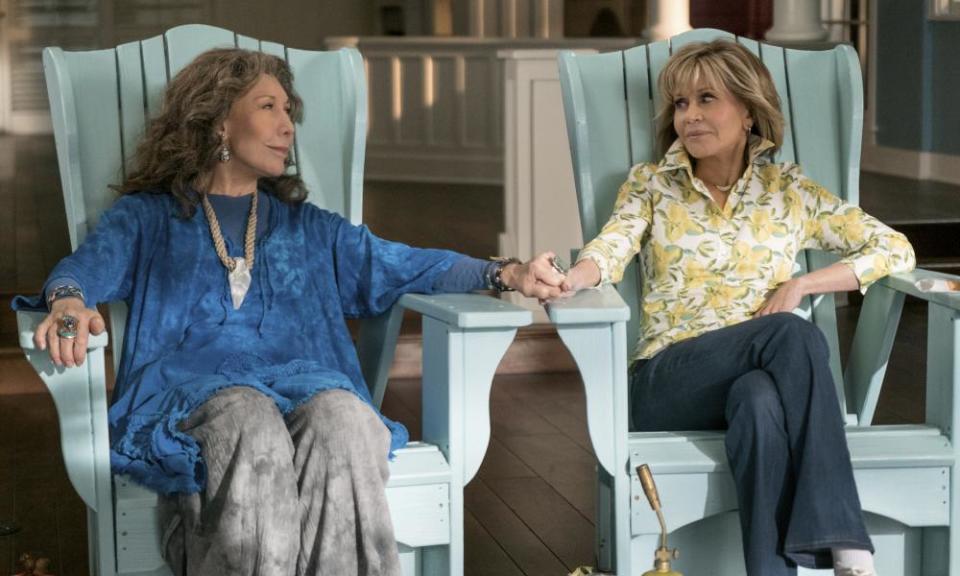We don't want to think about older people having sex but they deserve a place in our pop culture

In the age of online streaming, YouTube and a show for everyone, it seems that there has been a proliferation of shows about older people and ageing.
As a society, western culture does not properly value the elderly and older people. This lack of regard presents itself in many ways, ranging from abuse in nursing homes, jokes, discrimination in the workplace to invisibility. Even for those of us who respect older people, we still don’t necessarily see their full humanity. We do not want to know their fears, we do not want to imagine that they have sex lives, we can’t possibly imagine that they might have desires for their lives.
On screen this invisibility has meant older people have existed primarily as props or plot devices, only ever seen in relation to the primary younger characters. They are one-dimensional and usually good for the same gag. Think Marie and Frank in Everybody Loves Raymond, and Martin Crane in Frasier. Of course there are exceptions such as The Golden Girls and Ruth Fisher in Six Feet Under. Generally though, we haven’t seen enough nuanced depictions of complex older people.
This however is changing, with shows such as The Wire, the aforementioned Six Feet Under and The Sopranos heralding an evolution in television. It has only been in the last few years that we have seen a shift in the depiction of older people. In 2013, the New York Times published an article called Kids These Days: They’re All Older Than 50, which lamented the representation of older people, the crux of its argument being that television showed older people as crude buffoons where it used to depict them as wise. This article misses the point – whether crude buffoons or oracles, these are still narrow imaginings.
Imagining the elderly is imagining people having futures. Being Aboriginal, this can be challenging
There has been serious network funding and wide viewership for shows such as Curb Your Enthusiasm, Grace and Frankie, the Kominsky Method and Transparent. Although Transparent has been cancelled due to sexual assault claims against Jeffrey Tambor, who shouldn’t have been casted in the role of a trans woman in the first place, the success of these shows indicates that audiences are interested in the lives of older people. These shows, particularly those exploring the lives of older women, can help shift the way that we perceive growing old. It can change the way we think about ageing. Society convinces us that older people are irrelevant but television and film can shift this.
This development towards having more older people as main protagonists, while obviously positive, has largely benefited white people. Some of these depictions have been harmful. The Best Exotic Marigold Hotel and its sequel both examine the lives of older British people in India and their colonial entitlement to it, without examining the colonialism. We focus on them and their foibles while India, the place and its people serve largely as a backdrop. It presents the nation as a site of discovery (again) by white people. They are not immigrants, they are expats. Their whiteness is presented as innocence rather than destruction. Perhaps it wouldn’t be so problematic if it didn’t represent a trend existing in reality – white people often retiring in colonised countries. The television show The Real Marigold Hotel (or as we call it in Australia, The Indian Dream Hotel) has been running for three seasons and follows the lives of “famous” older British people travelling through India. Art imitates life, life imitates art.
This feedback loop is why I think we need older black people on screen. Imagining the elderly is imagining people having futures. Being Aboriginal, this can be challenging. Our parents and grandparents often die young, or spend years being unwell. I often relate to elders or my own grandparents, in their relation to younger people. I rarely imagine their intimate lives, I rarely imagine them as individuals. I position them as the elder and leave it at that. This is in part cultural, but if I am honest it is also a personal failing. I want to see older black people in all of their complexity. I want to see them make mistakes, have sex, fall in love, finally leave people they’ve been stuck with for forty years, learn new things, practice and pass on culture, buy motorbikes, start a band, keep families strong, come out, lead campaigns, maybe go to a festival and take the best pinger of their life. Except perhaps for the last point (although you never know!), these things already happen in reality. Why can’t art catch up?
A few months ago I told an elder I was writing for Black Comedy. They told me they liked the show. They said a lot of people were pissed off about the elders sketches from a previous season but they loved it because there were parts of those sketches that were true. We forget that older black people are consumers of pop culture.
Beyond consumption however, why can’t they also be creators? Older people have lives worth examining and understanding. They also have perspectives on the contemporary world that are worth exploring. They are our historians, and if we don’t give them creative control, we miss out on so much depth. By not including complex older characters or focusing primarily on them we miss out on understanding who we are as a people.
• Nayuka Gorrie is a Kurnai/Gunai, Gunditjmara, Wiradjuri and Yorta Yorta freelance writer

 Yahoo News
Yahoo News 